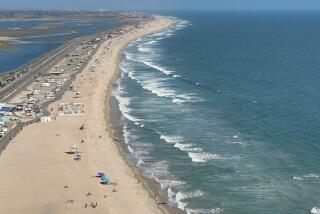FOR THE KIDS: LIFEGUARD TRAINING : Buoyed Spirits : Youngsters ages 9 to 15 learn about rescues and rip tides during a four-week class.
- Share via
One hundred and forty wet children, all in red swimsuits, are on the beach. “Do you like the sand?” booms the voice of a lifeguard instructor.
“We love the sand,” the kids boom back.
And so begins “sand appreciation,” one of the first drills for would-be lifeguards at Ventura State Beach.
Their bodies shivering from the 59-degree water, they roll around headfirst in the sand and crawl along the beach like iguanas, emitting growls.
“It itches and it’s grungy,” said Ben Chapin, 12, of Ojai. “They say it gets us closer to the sand.”
And possibly closer to a job as a lifeguard, the goal of many of the boys and girls who sign up for the junior lifeguard program sponsored by the state Department of Parks and Recreation.
Being a lifeguard is still considered cool, and the competition for local jobs is intense. However, in many areas of the country, there are few applicants for lifeguard jobs.
But this summer in California, the state added six new lifeguards to its staff of 42 covering the beaches from McGrath State Beach in Oxnard to Carpinteria. Nearly 90 showed up for the grueling tryouts.
And no one gets there by being a wimp. Just to get into the four-week summer program, the children, ages 9 to 15, must prove they can swim 100 yards. The classes, given from 9 a.m. to 1 p.m., begin with calisthenics. An ocean swim of 500 or so yards comes next, followed by a half-mile run on the beach.
“There are a few moans and groans the first day,” said Sandy Dungan, who heads the program. It doesn’t last. Any reluctance or obnoxious behavior is met with a command to assume the iguana position for the dreaded sand appreciation.
About one-third of the kids want to become lifeguards, Dungan said. The rest are there to become better ocean swimmers, get in shape, learn a little ocean ecology and sharpen their beach etiquette.
“The goal is to pass on enough information so they can keep themselves safe, and hopefully they’ll pass on what they learn to their friends,” Dungan said.
On this morning, as the surf pounds the beach and the sand heats to a scorch, the kids learn rescue techniques.
“This is a rescue buoy,” yelled an instructor, holding up a foam rubber belt attached to a long strap. “This is the lifeguard’s best friend. He goes everywhere with it.”
Then comes a lesson in how to wrap the belt around the buoy so that it shakes free when the lifeguard dashes into the water, belt looped around his shoulder, to swim to a stranded swimmer.
“How you wrap the buoy is important,” said Dungan, who has been a lifeguard for 15 years. “There is nothing so embarrassing as tripping on your buoy. Your friends will see you.”
Then instructors go over another rescue technique, involving what looks like a surfboard--an eight-foot-long foam paddle board used to pluck out surfers or windsurfers stranded farther out in the water.
For some, it’s a challenge just to climb on the boards and paddle with their hands past the breaking surf.
Some, such as 14-year-old Jaime Case, enter the program afraid of the waves, but that doesn’t last long.
“I was terrified of going under a wave,” said Jaime, who is attending her third summer of lifeguard classes. It took me three days to finally do it. Now I want to be a lifeguard real bad.”
In the class, students learn how to identify a rip current by the sandy texture of the water and the way a wave breaks around it. They also learn how to use a rip current to reach a stranded swimmer, and how to swim back at a 45-degree angle to avoid it.
“Ninety-nine percent of our rescues are rip rescues,” Dungan said.
They watch first aid films and practice resuscitation on mannequins. They learn tips on how to spot potential victims even before they get in the water. A dead giveaway is the “Nebraska wet suit,” a pale skin tone suggesting little exposure to the water. And then there is the swimmer confined to the dog paddle stroke.
At lunchtime, sandwiches are gulped down, and most of the kids return immediately to the water with their Boogie or surf boards. Others play volleyball or other beach games. No one sits still.
“This is not tan patrol,” Dungan bellowed at three girls reclining on their towels. “Get in the water.”
Despite the constant activity, the kids say they like it and many return for additional sessions. The four-week sessions are offered each July and August at a cost of $190. This year’s classes filled quickly and some children ended up on a waiting list.
“It’s cool; the only bummer is going swimming real early when it’s cold,” said Ted Reckas, 12, of Ventura. “The first year I didn’t want to do it but my mom said it would be fun. This is my third year. It’s a good way to get in shape.”
Older teen-agers can become assistant lifeguards to help out instructors and get an even closer view of the lifeguard’s job. They sit in the tower with the lifeguard and scan the water.
“That takes some of the glamour out,” Dungan said. “Ninety-five percent of the time the job is really boring. But you have to be really alert and watch the water for that split second when something can happen.”
* WHERE AND WHEN: For more information about the California Department of Parks and Recreation Junior Lifeguard program, call 643-5003. The cost is $190 for a four-week session. Two sessions are offered during July and August, from 9 a.m. to 1 p.m.


